Deep in the My Car Quest archives in the Wayback Machine from June 2012 I found this interesting article written by Dan Eastwood (from Michigan). Don’t forget to read the comments as well.
I love reader stories and if any of you want to make a contribution please send me an email.
Mike Gulett, Editor
Text and photos by Dan Eastwood –
My first awareness of the existence of the Intermeccanica Italia came my freshman year in college… Automobile Quarterly Vol. 9-3 had recently published a great article on Intermeccanica in 1970. It was so stunningly beautiful and yet practical with its American powertrain… it became seared into my brain as the car I would have to someday own.
It was another 12 years before I actually saw one on the road, and 30 years after first reading about them before I had the opportunity to buy one (when my financial resources could coordinate with finding an owner willing to sell).
The car had been parked 22 years earlier in a car barn – alongside a plethora of other beautiful, mostly Italian machinery – Alfa Romeos, Maseratis, & pre-Fiat Lancias, etc. The owner needed to sell a few cars to make room for some new projects so he decided to sell a few off. In my eyes, he sold me the most beautiful car he had, and to this day, he says I caught him in a weak moment. I was lucky we live in the same Zip code, so I told him he’d still be able to see the car from time-to-time and he was glad to see it get back on the road.
One of my first cars was a 1970 Fiat 124 Spider and I wouldn’t consider a sports car to be much fun if the top wouldn’t go down… but the reason he gave for not driving the Italia in 18 years was because it was a convertible – and his days working in automotive crash test labs – testing and evaluating impact effects with actual cadavers and crash-test dummies convinced him he wanted a hard roof over his head. He’d known for years that he was probably never going to drive the Italia again, but it took him many years to finally let go of such a beautiful car that was one of the highlights of his collection.
The Italia was in good running condition when he’d parked it around 1983 (with a mere 25,000 miles on it), but after 18 years we had to take the carb apart and clean it to get it running again. As I drove it out of his barn, the brake pedal had no effect, so he kindly let me continue to keep the car there until I’d rebuilt all the brakes. I had White Horse sleeve all the calipers so I shouldn’t have to re-do them for a long time.
A car this old is always going to need something worked on. The motor has been fairly reliable but annoyingly, the rebuilt water pump I put on it started leaking after a year, with fewer than a thousand miles on it – (sigh). Intermittent electrical glitches seem to be the main bugaboo of older cars – especially ones that sit awhile.
The original muffler system was gone, so I found a shop that would custom build me anything I wanted if I brought them the parts and showed them photos of how I wanted it done. I printed out rear-photos of all the V-12 powered Italian exotica I could find and came up with a set of dimensions for a four-tailpipe rear that would look very Italian. I ordered 4 Ansa tips off the web and found the other parts locally. The shop was great about making sure I was happy they were doing it right every step of he way – and in the end, it looked so good that Paula Reisner even commented on it in her recent book on the history of Intermeccanica.
The clutch pedal had way too much pedal travel – I was surprised that all the linkages were worn out after only 25k miles, so I took it to a machine shop and had them make bronze bushings for each part of the linkage until all of the slop was gone.
The Magnum 500 wheels aren’t too bad looking but they were shared with so many American muscle cars… What I most love about the car are it’s Italian looks, so I bought a set of Cromodora Italian mag wheels for it on eBay, but it turns out I’ll need longer wheel studs to mount them, so that’s one of my upcoming projects.
Some owners modify their engines for a lot more horsepower, but in a 2500 pound car, it’s got all the power I need to get into trouble very quickly and it can hang the tail out on corners ‘at will’, so I’m not making any plans to modify my 351W engine.
The interior is completely original, as is the convertible top – unusual for a car of this vintage for these parts to still be in such great condition. I try to keep the car as original as possible – even saving any parts I’ve had to replace in case I may want to restore them back to original again.
As a wet-behind-the-ears kid when I first read about this car, I thought it would change my life and make all my problems disappear… As an adult, I’ve come to see that it doesn’t quite work that way, but there is a deep satisfaction that came from fulfilling a promise I made to myself so many years ago.
More photos are in the slide show below.
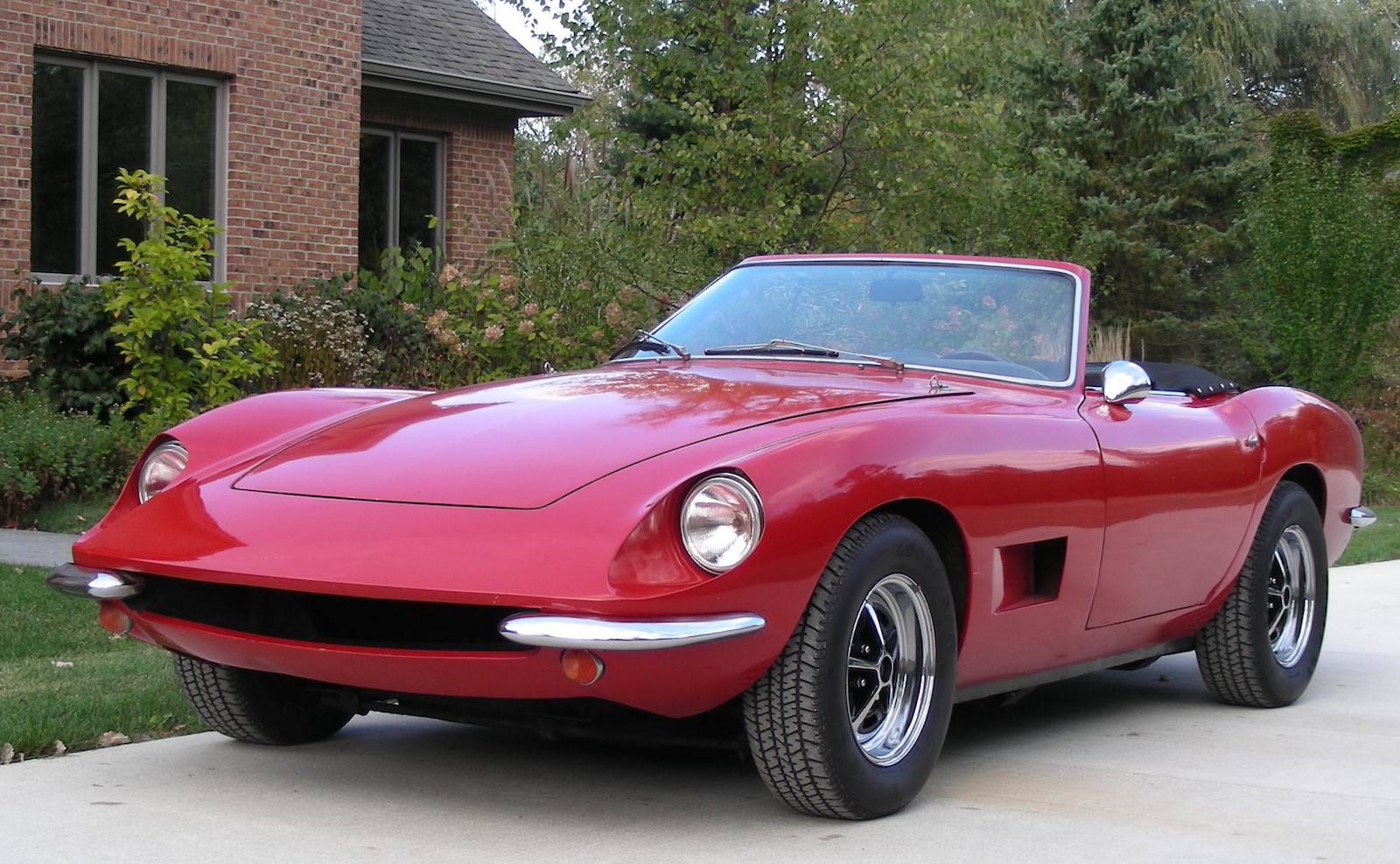
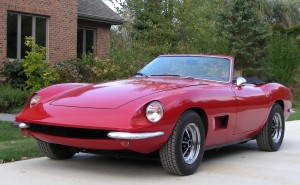
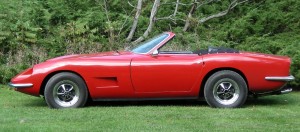
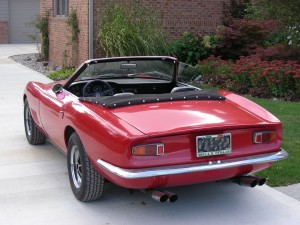
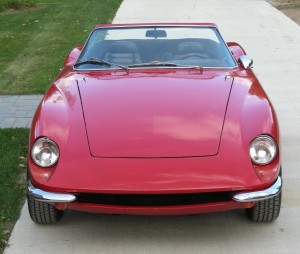













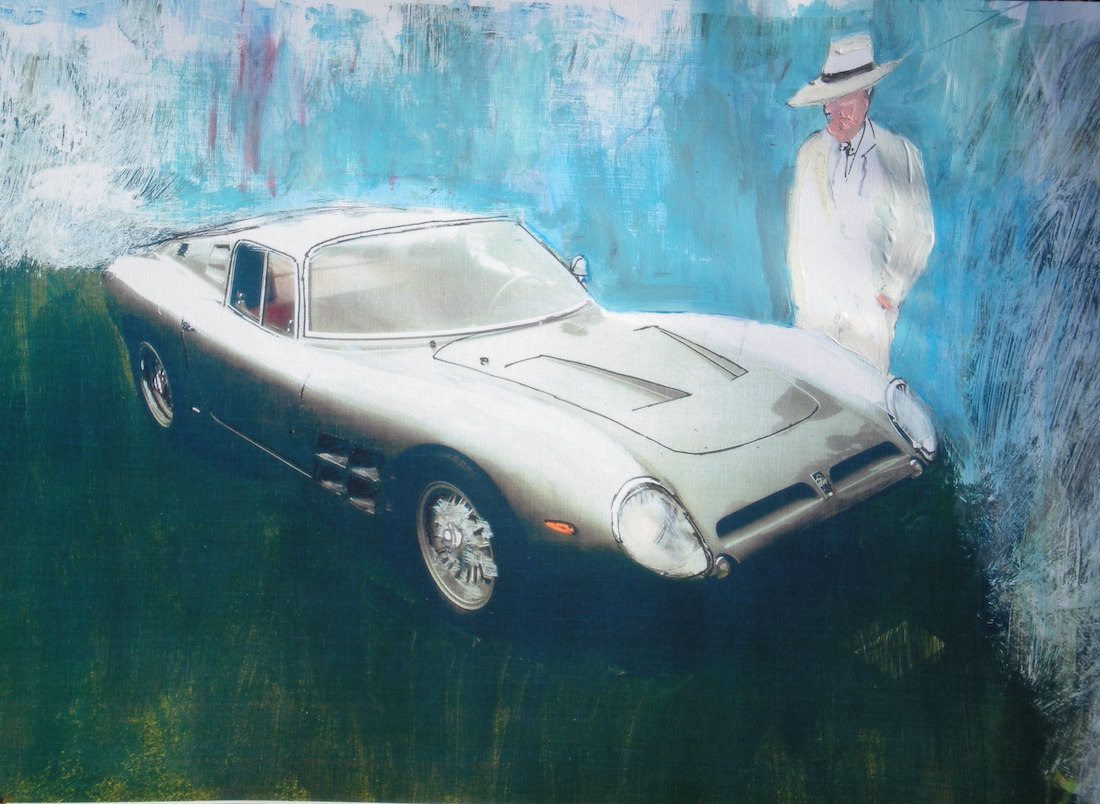

I remember, in the mid 60’s, while employed by High Performance Cars of Waltham, massachusetts, a customer
had purchased a brand new Italia, from the Volvo dealer, Foreing Auto, of Watertown, Massachusetts.
The real name these days, was; ITALIA GFX.! built by Intermeccanica.
Difficulties from front suspension, customer had asked that we correct the problem, & complained to the dealer for reimbursment of poor work, Intermeccanica refused, the whole argument wounded up in Waltham court, the Italians, were upset about “this French mechanic” who critisized their work
company had financial problems & came back in the US market, under new american management, with Mr. Weaver, at that time the car was sold under the name TORINO..
that is all for today
i have a picture of that original car in my slides collection, was silver then, I remember a very nice blue as well
Thank you for the story. It would be great if you could send in the old pictures.
Great looking car! Thanks for posting all these great pictures.
Bruce,
Thank you and I also thank Dan Eastwood for providing these great pictures of his beautiful car.
Thanks Mike for such an amazing discovery. What a beauty. I didn’t even remember its existence! Thanks for the great article and pics! Keep up the good work!
Mark,
Thank you for the comment. I am sure the writer/owner Dan Eastwood appreciates the comment!
Yes! – Thank you very much!
– Dan Eastwood
….i have a great story re: this car. in 1970 i was a sophmore at a small college in k.c., mo. there was a freshman who’s dad bought him an italia for h.s. graduation. he was driving home to chicago one weekend and asked me if i wanted a ride back to chicago with him. we were cruising alonmg i-70 just outside st. louis when a vette pulled up along side us and signaled they wanted to drag. this kid said, “should we” and i said “why not” next thing i remember we were going around 130 mph and the vette was left in the dust. never forgot this. man, was that car fast!!!
Great story, thanks.
In 1967 The Omega was created from the Griffin motor car company.
Purchased by the late Steve Wilder he was my uncle, he only built 30 cars.
Sold one to Sonny and Cher !
Sold the name Omega to General Motors
Changed the name to : The Intermeccanica Italia
I’d like to add some corrections and additions to Dave’s comment. So many errors have crept into the Intermeccanica History record over the years that I feel it’s best to correct them quickly before they are repeated as facts. Hopefully, I am not contributing to similar errors, so if anyone can correct or improve on the assertions I am making below, I welcome any efforts to set the record straight.
Jack Griffith was a Long Island, NY Ford dealer who founded the Griffith (not Griffin) car company – as Mike has written extensively about. Early Griffiths used TVR bodies with Ford powertrains, but Jack found the TVR supply chain to be unsteady and easily interrupted by shipping strikes and other problems.
Jack Griffith met Frank Reisner (Intermeccanica founder) at the NY Auto Show – liked what he did with the Apollo, and worked out a deal to have Reisner supply an all-new, all-steel body for a new Griffith to be known as the Griffith 600 which would replace the TVR-supplied bodies. Reisner asked Jack for a design direction, so Jack contacted Bob Cumberford (formerly of GM design staff) to supply some drawings.
Reisner later claimed that Cumberford’s drawings were used as the starting point basis for the Griffith 600 design, but the lack of details and dimensions required Intermeccanica to contribute significant input to make the design workable for legroom, door fitments, etc. Fortunately, Reisner already had a working relationship with Franco Scaglione – one of Italy’s top design geniuses – who was able to ‘productionize’ the design by making some changes. When Cumberford heard that changes were being made, he hopped a plane and immediately flew to Turin to demand that his design not be tampered with. As beautiful as the Italia is, I heard that some of the changes Scaglione planned for it would have made it even more beautiful had Cumberford not insisted on certain changes back to keep it ‘his’ design.
Griffith went bankrupt while trying to launch his new Griffith 600 car using bodies built by Intermeccanica in Italy and shipped without powertrains to Griffith’s Long Island shop. Jack only took delivery of 12 cars and these cars were ultimately completed using Plymouth 273 ‘Commando’ engines before Griffith had to shut down operations.
Presumably, Cumberford was not paid by Griffith for his design efforts and had a personal interest in seeing the project succeed. I’m not sure who introduced whom to whom, but a wealthy New England automotive enthusiast (with an engineering degree from MIT) named Steve Wilder, worked with Bob Cumberford and Holman-Moody to keep the Griffith 600 design alive – reborn as the “Omega”. Bob was employed as a designer by Holman-Moody in Charlotte, North Carolina, and Holman-Moody was the outlet through which Ford sold aftermarket engines (and other powertrain parts) to racers, boat manufacturers, industrial application users, etc.
Actually 33 cars (not 30) were completed by Intermeccanica and shipped to Omega, but three of these had to be destroyed in testing to comply with new requirements to meet Federal Crash Safety standards, leaving thirty cars to be sold to the public. I think it was David E. Davis who reported that Wilder was daily(?) flying between North Carolina and his home in the Northeast (New York? – perhaps Dave can shed some light on this)…
Regardless, Wilder chose to abandon the project after only 30 cars were sold, commenting that he was giving away $1,000 with each car sold. I’ve read somewhere that he later made more than enough money on the sale of the rights to the ‘Omega’ name to GM (for use on their Oldsmobile) than he’d lost on the Griffith/Omega project… but another source said that it was Cumberford who made the money on the sale of the name. Again – I’m hoping Dave (Steve Wilder’s nephew) can shed some light on this.
Back when the whole project started, Reisner had been told by Griffith to expect orders for hundreds of cars per year, so he’d invested heavily in fixed tooling to produce the frames and to then accurately weld the hand-made bodies to the frames. Pictures of the tooling can be seen in the excellent article in Automobile Quarterly Vol. 9-3. No doubt this tooling contributed immensely to the rigidity and quality of the bodies that Reisner produced, but after only receiving orders for 45 cars in two years, Reisner wasa at risk that all he’d invested in the project could have died with the Omega. Reisner also realized that some of the customer complaints about the car might be better solved if the powertrains were installed in the cars in Italy so that he could personally road test each completed car and correct any bugs before shipping it…
So Reisner put together the financing and a U.S. dealer network using Genser Forman – the importer of Triumph automobiles into the USA (hence the early cars had the letters “GFX” for Genser Forman Experimental), added to the name. Frank initially planned to sell the cars as the Intermeccanica “Torino GFX”, since he was based in Turin Italy (known to Italians as the city of ‘Torino’). Only a handful were sold under that name before Ford made it known they had a new car coming out for which they planned to use the name ‘Torino’. Reisner was buying all his powertrains from Ford, so he wisely chose to change the name of his car to the ‘Intermeccanica Italia GFX’. Wilder had no involvement in these name changes.
Simultaneously, Reisner and Scaglione made several styling changes… Gone was the one-piece front bumper, replaced with two ‘barbels’ that resembled the Ferrari 275 GTB’s front bumperettes. Added to the line-up was a new convertible roadster that became very popular with customers (myself included, as for a tall guy like me I find the coupe to be claustrophobic).
There’s been a long-running controversy between Robert Cumberford and Frank Reisner as to who deserves credit for the Griffith/Omega/Torino/Italia styling. Cumberford claims all the credit since he’d been hired by Griffith to submit the initial design. Frank Reisner claimed that Scaglione deserved more of the credit for productionizing. Cumberford’s sketch and drawing to make the design actually work – based on Scaglione’s many years of actually designing real production cars that had to be fully functional. Reisner said that the Cumberford design would not fit the full-sized Americans for whose market the car was designed. Karl Ludvigsen, and authority on automotive history probably said it best in his homage to Steve Wilder, when he referred to the Griffith/Omega/Torino/Italia as “built in Italy by Intermeccanica to a design by Bob Cumberford productionized by Franco Scaglione”. In another article written by Mr. Ludvigsen on Scaglione’s body of work, Ludvigsen gave Scaglione full credit for the design of the convertible version of the Italia.
Thank you for sharing your knowledge.
That was a great recounting of the history. I’ve seen about ten Italias/Torinos over the past 55 years and they really are great looking cars and with the Ford drivetrains should be less problematic to maintain……more on that later.
I saw what could have been a Torino (or maybe an Italia) in the showroom of a used car dealership in Central Connecticut in August of 1968. I was there selling my car because my “sponsor” in the US Air Force told me not to bring a 66 Riviera to Japan because of the narrow streets, poor quality gas, etc. He was not a car guy as had he been he would have told me to bring it because the Japanese had nothing like it and I could sell it for twice the current new price. C’est la vie. I sold it in Connecticut and when I got to Japan I bought a 1961 Toyopet (precursor to Toyota) four door sedan in a color similar to Shelby’s Sunset Gold. We named it the Golden Flash. I paid $200 to the sergeant selling it and sold it three years later for $100. The only maintenance it needed was one tuneup (plugs and points) and some oil changes. A/C was frosty beyond belief but tough on the rear seat passengers because the blower housing was in the trunk. Funny story about the tuneup. When I went to buy the plugs and points the sales guy in the local store asked me what distributor it had. I asked why and he said that year Toyopet bought three different distributors for that model. Not standard like today.
Back to the Torino/Italia. It was gorgeous. Black with a saddle interior. Never forgot it. Wished I’d traded the Riviera for it and brought it to Japan. The only sports cars we saw much of were the Honda 500’s, 600’s and maybe the 800’s. Another great little car. Imagine a four cylinder with double overhead cams and four carbs in 1968-71?
For all their looks and American running gear the Torino/Italia cars haven’t increased in value much based on the few sales I’ve seen at auction. And, for some reason the Italias I’ve seen have had irregularities regarding the body not being aligned properly at the rear. I’ve seen three sold over the past 5 to 10 years and all had one rear tire well within the wheel well and one slightly sticking out. One seller solved the problem by putting three 215/70/15 tires on the two front wheels and one rear wheel while the other rear wheel had a 185/70/15 tire on it. Made it harder for the wheel arch to damage the tire I guess but I can envision lots of problems with the rear end with two tires of such wide differences in diameter. One of the three was a no sale but was seen again at an auction about a year later with the body properly aligned. Problem solved the right way but probably not cheap to do.
I owned a 1969 Italia convertible which I bought in 1973. I eventually sold it in the 1990s. It had a very stiff suspension with 4 very rigid coil springs and Bilstein shocks. However the reason some cars would not be aligned in the rear is because it used a panhard rod that connected the differential to the opposite side frame. This was used to align the differential to the body laterally. The panhard rod length could be adjusted if it was removed. If it was not adjusted correctly, the car would have the misalignment that you referenced
Thanks for clearing that up.
Steve lived a few doors down from me in Plandome Manhasset, NY.
Yes he did spend time in North Carolina at the Holman-Moody plant.
The Omega was also in NY Auto Show at the time, and featured in Automobile Quarterly.
I was seven when all of this was going on.
Very good memories, although I don’t quite as much as Mike
Thanks
This message is for Dave……do you know if you uncles Omega was a automatic? Thank you…
As I remember they were all 4 spd’s
Thanks
I owned one new when it was called a Torino- 289 Ford. It’s interesting to see them idolized today. Mine was a piece of junk that literally fell apart in front of me. The paint failed -turned orange and crazed. The body pulled away from the frame. And worst of all: the steering wheel one day just spun in my hands like a roulette wheel.. Fortunately I was parking it.The exhaust fell off and had to be custom fabricated. This is only a short listing of a litany of awful things that happened
It was refreshing to read Bill’s comments because all too often, 30 or 40 years after a car is introduced, the newcomer writers praise it to the max without checking owner experiences. I drove one once and it performed well, had great styling but I suspected the engineering was marginal, and in a sports car sometime pushed to the max, you don’t want marginal. Now I don’t think one is worth restoring because you would still have a car that was built on a budget that stopped them from making everything right.
The body styling reminds me of the Apollo. Beautiful!